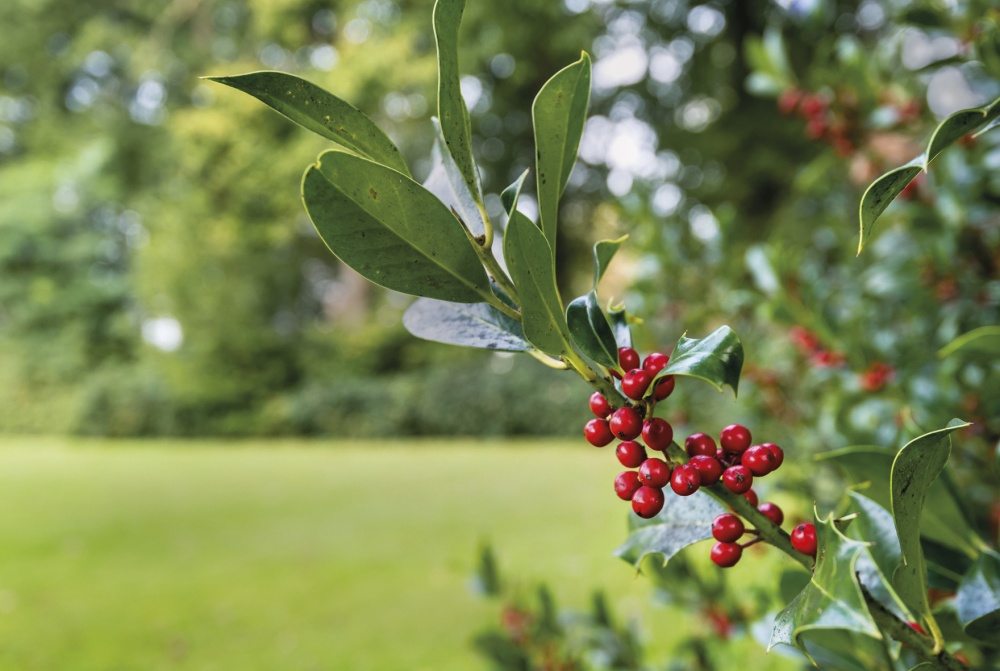Liven Up The Garden With Evergreens

Vanessa Cook of Stillingfleet Lodge Gardens and Nurseries guides us through the world of evergreens
To begin, I must admit to a dislike, almost hatred, of conifers and heathers. They look good in gardens where they are the local vegetation, so Scotland, parts of Wales and the Lake District are suitable areas. I think my dislike is partly due to visiting Alan Bloom’s garden in the flat Norfolk countryside, which in the 1980s consisted of only conifers and heathers! I know changes have been made to the garden recently and it was a type of gardening popular in the same way that now everyone wants a ‘prairie garden’.
So having crossed that frontier we can discuss other trees with evergreen foliage. Ilex (Hollies) are excellent in the garden, you can cut them hard to keep in shape and there are many different foliage forms. Ilex x altaclerensis ‘Camelliifolia’ is the camellia leaved holly. Smooth dark green leaves, so no damaged hands when picking, and it’s a free-berrying female form. Ilex x altaclerensis ‘Lawsoniana’ also has leaves with few prickles and the dark green leaves have an irregular golden variegation. It is also female. Ilex aquifolia ‘Bacciflora’ is a form of our native holly with prickly dark green leaves and large clusters of creamy-yellow berries. Ilex aquifolia ‘Golden Queen’ is the one that catches everyone out as it is male and so has no berries despite its name – it does have lovely green leaves edged with yellow. You need a male form for pollination so if you have a holly and no berries you now know why! There is an unusual form with small box-like foliage, Ilex crenata, this has a fastigiate form and makes elegant small evergreen pillars. I have all these hollies in my garden and love to be able to pick armfuls of branches to decorate the house for Christmas.
There is another interesting tree with Ilex in the name, this is Quercus ilex, the Holly or Holm oak. Coming from the Mediterranean it is astonishingly tolerant of our northern climate. It is only suitable if you have a large garden although it makes an excellent hedge as does holly. The leaves are dark green and leathery with a whitish underside, catkins appear in the spring followed by small acorns. Anyone visiting us via the A19 drives through an avenue of old established trees which look good all through the year.
Arbutus unedo, the Strawberry Tree, is a fascinating small tree. The leaves are small and glossy and the bark is brown and sheds in an attractive way. It is interesting in that the flowers are produced in late autumn, masses of small white bells, and the fruit which look like small red strawberries, take a year to mature, so often a tree has flowers and fruit at the same time. They dislike root disturbance so buy a small plant and grow it where it will be sheltered from the wind.
Eucryphia x nymansensis ‘Nymansay’ is one of the trees in my garden that is much talked about by visitors. It is a tall columnar tree with dark green evergreen foliage and the most wonderful large fragrant white flowers with a prominent boss of yellow stamens, best of all it flowers in August when there are few trees in flower. It is easy to grow as long as it has protection from too much wind.
So now we have a backbone of evergreen trees in the garden we can look at shrubs to clothe your walls. At the moment my north-facing house wall is covered with Garrya elliptica ‘James Roof’. This is a male form and has the most attractive silvery catkins during the winter. The evergreen foliage is soft grey green and as it is a shade-lover it is ideal for north or east-facing walls or large fences. Pyracantha (Firethorn) is another good shrub for shady walls as well as making an excellent hedge. Small dark green leaves and either orange berries, Pyracantha ‘Orange Glow’ or yellow berries Pyracantha ‘Flava’. I have Cotoneaster salicifolius ‘Herbstfeuer’ on my barn wall – this is very attractive as the main stems are tied to the wall and the branches then cascade downwards, covered with white flowers in the spring and masses of red berries in the winter. The berries last longer than most in the garden, the birds seem worried about landing on the weeping branches.
I have Euonymus fortunei ‘Silver Queen’ covering a nasty red brick garage. This is usually used as ground cover but trained upwards it is thickly covered with green and white foliage which is ideal to pick throughout the year.
One more shrub to grow against a wall: Magnolia grandiflora. I have this on our west-facing house wall and it delights me every August as I look out of my office window and see the flowers like huge creamy-white bowls. The large leathery dark green leaves look good all year and are untouched by the winter weather, as the flowers open in late summer they also are not frosted which often happens with spring-flowering Magnolias. It does grow large and needs a sheltered sunny wall but oh how wonderful it is!
In my next article I will talk about evergreen shrubs and climbers, hoping I will inspire some of you to grow more evergreen foliage plants. In the meantime may I suggest as you curl up in front of the fire in the cold winter months you read The Winter Garden by Val Bourne, full of ideas for adding structure and plants in the winter months. Or, if you want a book to make you think about summer, Dream Plants for the Natural Garden by Henk Gerritsen, the book that has had the most influence on my gardening. Happy planning!



